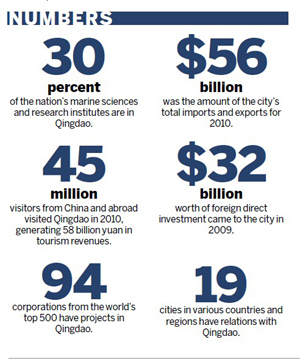News
A unique recipe for real happiness
By Xie Chuanjiao and Zhang Zhao (chinadaily.com.cn)
Updated: 2011-05-23 14:59
 |
Large Medium Small |
Blue economy
Over the next five years, the city government plans to turn the city into a leading center of “blue economy” development, focusing on maritime industries.

It is also trying to improve its fishing industry, marine equipment manufacturing and engineering, and related chemical industries. It sees new energy and ocean ecology as emerging sectors.
The city and its surrounding areas are major aquaculture bases, contributing 10 percent of China’s total fish exports, leading all coastal cities for nearly 20 consecutive years.
Qingdao was one of the first 14 selected cities to benefit from the central government’s opening up and reform policy. It now contains a State-level economic and technological development zone, a high-tech development zone, and a bonded zone, which have preferential policies to attract foreign investors.
Qingdao also has relations with various cities in 17 countries and regions, while more than 2,000 foreign business associations and enterprises have offices here.
Several dozen corporations from the world’s top 500 also have projects here. One example of this is the Pakistan Haier-Ruba Economic Zone, China’s first overseas economic and trade cooperation area, a joint operation involving the Haier Group and Pakistan’s Ruba Group.
The city’s total import and export volume for 2010 was $56 billion. It also has $36 billion worth of direct foreign investment.
City of noted brands
A number of prominent international brands got their start in Qingdao, including Haier, Hisense and Tsingtao beer. The Tsingtao Brewery, founded in 1903, is now one of the world’s top 10 brewers.
The city’s service business includes port logistics and tourism, which are considered a major part of Qingdao’s future development plans.
The city has been a tourist destination and health resort since at least the 1920s. And its beaches, century-old European-style buildings, and Laoshan Mountain, which overlooks the sea, are some of the most popular tourist attractions.
Last year, the city had 45 million tourists, 1 million of them from overseas. Tourism-related revenues amounted to 58 billion yuan ($8.9 billion), or more than 10 percent of the city’s GDP.
| 分享按钮 |